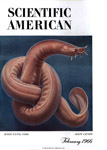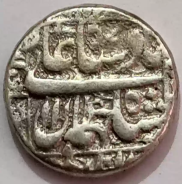 One of DD Kosambi’s last articles was a paper submitted to Scientific American entitled Scientific Numismatics, that was published in Volume 214 of that journal in February 1966. In this short article (10 pages in all) he summarises his main contributions to numismatic metrology, especially in relation to the statistical analysis of hoards of old coins.
One of DD Kosambi’s last articles was a paper submitted to Scientific American entitled Scientific Numismatics, that was published in Volume 214 of that journal in February 1966. In this short article (10 pages in all) he summarises his main contributions to numismatic metrology, especially in relation to the statistical analysis of hoards of old coins.
The gist of Kosambi’s arguments is that with increased circulation and usage, the average weight of a coin will decrease, and with increased usage in transactions, the spread in the weights of a group of coins of the same denomination will increase. His publications on these matters date back to the 1940’s. As he says in his autobiographical note, Steps in Science, he took up this problem as a way of learning statistics! Not able to make much headway with analysing examination marks in the Indian system, he turned to the statistical study of punch-marked coins. He noted that “not all coins issued at the same time are used in exactly the same manner. Therefore, the effect of circulation is to decrease the average weight but also to increase the variation”. On how these observations have influenced Indian historiography, there is more, much more, in his various articles on the subject, but that is grist to another mill.
In 1929 DD Kosambi (or DDK) graduated summa cum laude from Harvard College. He had been admitted to Harvard in 1924, but had taken what would now be called a gap year, leading to a “mid-year” graduation, a short note on which appeared in the New York Times on March 4. In any case, DDK was considered a member of the Class of 1929 and the yearbook mentions some of his academic honours, but is missing his photograph.
Also in 1929, in the Annual Report of the Fogg Museum, the Director includes a list of GIFTS AND PURCHASES, wherein he acknowledges receipt of a set of 26 silver Indian Coins from Kosambi:
![]()
Both the Director as well as the Curator of the Fogg Museum wrote letters of thanks to DDK and these are among the Kosambi papers in the PMML archives so it clearly meant a lot to him, but for whatever reason he does not mention these coins again in any of his writings.
When I first learned of this a few months ago, the donation seemed both exceptional and very generous. DDK was not yet 22 years of age and had gone through Harvard on a shoestring budget. He was also one of the few overseas students there at the time and his social profile was quite different from the few other students who had made gifts to the museum. Exactly what induced him to make this donation to the Fogg remains unclear, and the few accompanying documents in the archives at Harvard are sparse on details.
An additional complication emerged: the coins have, in the words of the Museum staff, been unlocated since the early 1970s. Unlocated has a complicated connotation so more about this elsewhere, but in short the coins could not be physically examined. There was some other information available, but the actual coins are now not available to view.
 Further correspondence, and a visit to the Fogg, threw up some more details. I had conjectured that the coins were likely to be from either Portuguese India (of which he was then a citizen) or British India (where the family was then living) so it came as quite a surprise to me to learn that the records at Fogg indicated that these were “26 Indian silver coins from date of Shah Jahan onward”!
Further correspondence, and a visit to the Fogg, threw up some more details. I had conjectured that the coins were likely to be from either Portuguese India (of which he was then a citizen) or British India (where the family was then living) so it came as quite a surprise to me to learn that the records at Fogg indicated that these were “26 Indian silver coins from date of Shah Jahan onward”!
This was more than just intriguing. Where did he get the coins from? And when? The two trips that Kosambi made from India were in September 1918 (when he was 11) and in early 1926, and a set of 26 Mughal coins, while not excessively expensive at the time, would still be outside the scope of what little is known about his father, Dharmananda Kosambi, and his financial conditions, especially as an indulgence. A little more sleuthing revealed that the coins had already been given to the museum as a loan perhaps in 1927, but they had briefly been misplaced and found again in 1928, but there are few other details. Are the coins all from one period? Since the note says “Shah Jahan onwards” it would suggest that they are from different Mughal mints, but one cannot tell for sure. There are tantalizing clues that these are mostly silver rupiyas, but at least three were of other denominations. This is also a mystery, since the Mughal mohur was cast in gold, and the dam in copper, and these coins are all classified as being silver.
The matter stands at this point now since the coins are physically not there. After donating the coins in February 1929 Kosambi returned to India in July that year and did not go back to the US till 1948. His first paper on the distribution of coin weights did not appear until 1940 – a paper in the journal Current Science (Bangalore) was followed up in a longer article in The New India Antiquary, vol. IV, pages 1-35, in 1941. But these are almost exclusively pertaining to the Taxila hoard and do not discuss Mughal coinage at all. Indeed, none of Kosambi’s articles on Numismatics do, and the papers that talk about silver coinage refer to other hoards. This is particularly strange since much more information is available on the economy of the Mughal empire. Indeed the only more modern coins that Kosambi refers to are British India rupees.
Some of these papers are well worth re-reading, not least for their acerbic wit. But more importantly, DDK notes in one of his articles, “I wish to point out the necessity of studying hoards of coinage as a whole and for every period if we are to reconstruct the lost economic and political history of our country from our unusually meagre and conflicting records.”
Whether or not the 26 pieces of silver – that almost surely was the first such hoard that he had had access to – triggered his interest in numismatic metrology, it is difficult to conclusively assert. In the absence of any further information, it is perhaps wisest to follow the caveat DDK gave in his superb 1941 article on the silver punch-marked coins of the Taxila hoard that were described in a Memoir of the Archaeological Survey of India by E.H.C. Walsh. Kosambi says “It is unfortunate that this Memoir should be the foundation of the present study, because it is full of errors and oversights; in any case, it is the only description of large, approximately dated, hoards available to me, and I advise prospective readers to use it with caution and with my commentary on it”.
“A Silver lining..” for DDK. Very well written Ram.
LikeLike